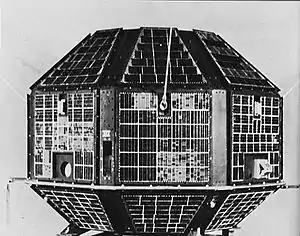| Mission type | Communications |
|---|---|
| Operator | EADS Astrium |
| COSPAR ID | 1981-057B |
| SATCAT no. | 12545 |
| Mission duration | 2 years, 3 months |
| Spacecraft properties | |
| Manufacturer | |
| Launch mass | 350 kilograms (770 lb) |
| Start of mission | |
| Launch date | 19 June 1981 |
| Rocket | Ariane 1 |
| Launch site | Kourou ELA-1 |
| End of mission | |
| Deactivated | 19 September 1983 |
| Orbital parameters | |
| Reference system | Geocentric |
| Regime | Geostationary |
| Longitude | 102° East |
The Ariane Passenger PayLoad Experiment (APPLE), was an experimental communication satellite with a C-Band transponder launched by the Indian Space Research Organisation on June 19, 1981, by Ariane, a launch vehicle of the European Space Agency (ESA) from Centre Spatial Guyanais near Kourou in French Guiana.
APPLE was India's first three-axis stabilised experimental Geostationary communication satellite. On July 16, 1981, the satellite was positioned at 102° E longitude. The 672 kg[1] satellite served as testbed of the Indian telecommunications space relay infrastructure despite the failure of one solar panel to deploy. Solid-propellant based Apogee Boost Motor to circularize APPLE's orbit was derived from SLV-3 fourth stage.[2]
It was used in several communication experiments including relay of TV programmes and radio networking. It was a cylindrical spacecraft measuring 1.2 m in diameter and 1.2 m high. Its payload consisted of two 6/4 GHz transponders connected to a 0.9 m diameter parabolic antenna. It went out of service on September 19, 1983. R. M. Vasagam was the project director of APPLE during 1977-1983.[3][4]
| Mission | Experimental geostationary communication[5] |
| Weight | 670 kg[5] |
| Onboard Power | 210 watts[5] |
| Payload | C-band transponders (Two)[5] |
| Launch Date | June 19, 1981[5] |
| Launch Vehicle | Ariane -1(V-3)[5] |
| Orbit | Geosynchronous[5] |
| Mission life | Two years[5] |
See also
References
- ↑ "ISRO success stories". THE HINDU. 28 April 2001. Archived from the original on 17 October 2006. Retrieved 2013-03-17....This important opportunity was utilised to build indigenously a 672-kg state-of-the-art three-axis-stabilised (as against the spin-stabilised Aryabhata) geosynchronous communication satellite called APPLE – Ariane Passenger Payload Experiment – which was launched in June 1981.
- ↑ Raj, N. Gopal (2014-09-10). "Trusty engine on Mars Orbiter to be tested yet again". The Hindu. ISSN 0971-751X. Retrieved 2021-04-24.
- ↑ "Biodata RM Vasagam" (PDF). BIT Mesra. Retrieved 4 August 2020.
- ↑ From fishing hamlet to red planet (PDF). Harper Collins. 2015. ISBN 9789351776895. Archived from the original (PDF) on 24 April 2021.
- 1 2 3 4 5 6 7 8 "Welcome To ISRO :: Satellites :: Geo-Stationary Satellite :: APPLE". Isro.org. 1981-06-19. Retrieved 2013-03-17.

